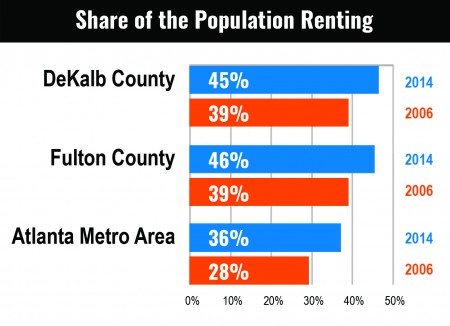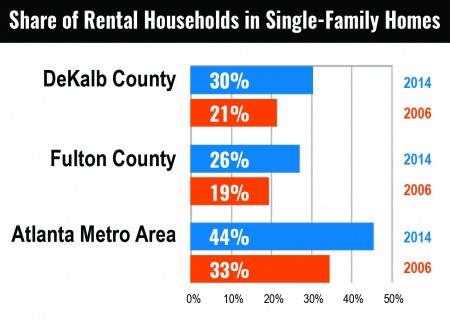The dream of suburban home ownership appears to be changing.
Renters are heading to the suburbs. Not just to fill the stacks of apartments rising across Sandy Springs, Brookhaven and Dunwoody, but also in single-family homes. In metro Atlanta, as in big cities across the country, the percentage of renters of suburban homes is rising, according to a new NYU Furman Center/Capital One study.
“You see a block of homes and you think, ‘That is all owner-occupied,” said Brad Karfunkel, senior data analyst for the NYU Furman Center and co-author of the study, which was released March 8. “A significant block of it is not.”

Chapman Hall Realty agent Avi Shemesh in front of a Brookhaven rental home he listed for $4,000 a month.
The study’s authors crunched census data for the 11 largest metro areas in the U.S., including metro Atlanta, and determined the number and share of renters increased in both cities and surrounding suburbs from 2006 to 2014, and that rental housing stock grew faster than the “ownership stock” in all 11 communities.
In metro Atlanta, the share of the population renting homes in the suburbs increased to 36 percent in 2014, as compared with 28 percent in 2006, according to the NYU Furman Center/Capital One study. At the same time, the share of renters in single-family homes or townhomes rather than apartments or condos increased to 44 percent in 2014, from 33 percent in 2006. And the number of rental units in the metro area increased by 26 percent from 2006 to 2014, the third highest rate among the 11 cities studied, the report says.
“What we see going on in Atlanta is that there’s a pretty widespread increase in renters living in single-family homes and a large number of the renters are outside the city of Atlanta proper …,” Karfunkel said in a recent telephone interview.
“The renting population is very much in the suburbs.”
The pattern holds true in Reporter Newspapers communities, too. When Karfunkel checked available data on Sandy Springs at the newspapers’ request, he found the share of the population renting homes increased to an average of 51 percent in the years 2010-14, up from an average of 42 percent from 2005 to 2009. “It’s gone up by more than 9 percentage points, which is a lot compared to suburbs of metro areas nationwide,” Karfunkel said.

Little historical census data is available for the newer cities of Dunwoody and Brookhaven, Karfunkel said, but he was able to calculate that the share of population renting in 2010-2014 was about 41 percent in Dunwoody and about 52 percent in Brookhaven.
Why the increase in suburban rentals? Karfunkel says he can’t tell just looking at the numbers, but said it may reflect the number of residents who lost homes in the recession and have not bought new ones. “It may well be that that some of the people living in these rental houses could be living next door to a house they used to own,” he said.
Local real estate agents also have noticed the rise in home rentals in the suburbs in recent years and offer various possible reasons for the shift.
Some suggest that more suburban houses are being offered for rent because demand for the properties is strong. On one recent day, zillow.com listed 39 houses for rent in Sandy Springs, 14 in Dunwoody and 24 in Brookhaven. Altogether, 767 houses were listed for rent in Fulton County and 590 in DeKalb County.
“I think it’s being driven by a strong market. People say, ‘Why should I sell my house for X dollars when there are people are willing to rent?’” said Belinda Cook, an associate broker who represented one of the Dunwoody rental homes listed on zillow.com and who also handles her own rental property.
“The market is hot” locally for both home rentals and sales, said Sandy Springs agent Avi Shemesh of Chapman Hall Realty. A three-bedroom, two-bath Brookhaven home he listed to rent at more than $4,000 a month attracted five potential tenants in less than a month, he said.

Shemesh thinks local demand reflects interest in jobs in Atlanta. “More people are coming to Georgia,” especially in the movie and music businesses, he said.
Cook thinks the rising interest with suburban rentals lies with millennials. Some, she said, want to live in close-in communities, but still want a yard. “They used to live in apartments more and I think they want to live in houses,” she said. “They’ve found friends they get along with [to share rent], and they want to have animals, and it’s hard to have a pet in an apartment.”
The NYU Furman study found that despite the increase in overall rentals, the median household income of renters in the metro area actually has declined slightly, to $36,400 in 2014 from $37,000 in 2006. Over the same period, median gross rent has barely budged, to $980 in 2014 from $970 in 2006.
“Of the 11 metro areas studied, Atlanta is among the more affordable metros, with 37 percent of the recently available units affordable to the median renter household in 2014,” the study said.
Still, the population of renters grew by 40 percent between 2006 and 2014, faster than the number of available rental houses, which increased by 26 percent over the period. That, the study found, meant the rental vacancy rate dropped to 10 percent from 13 percent over the period.
